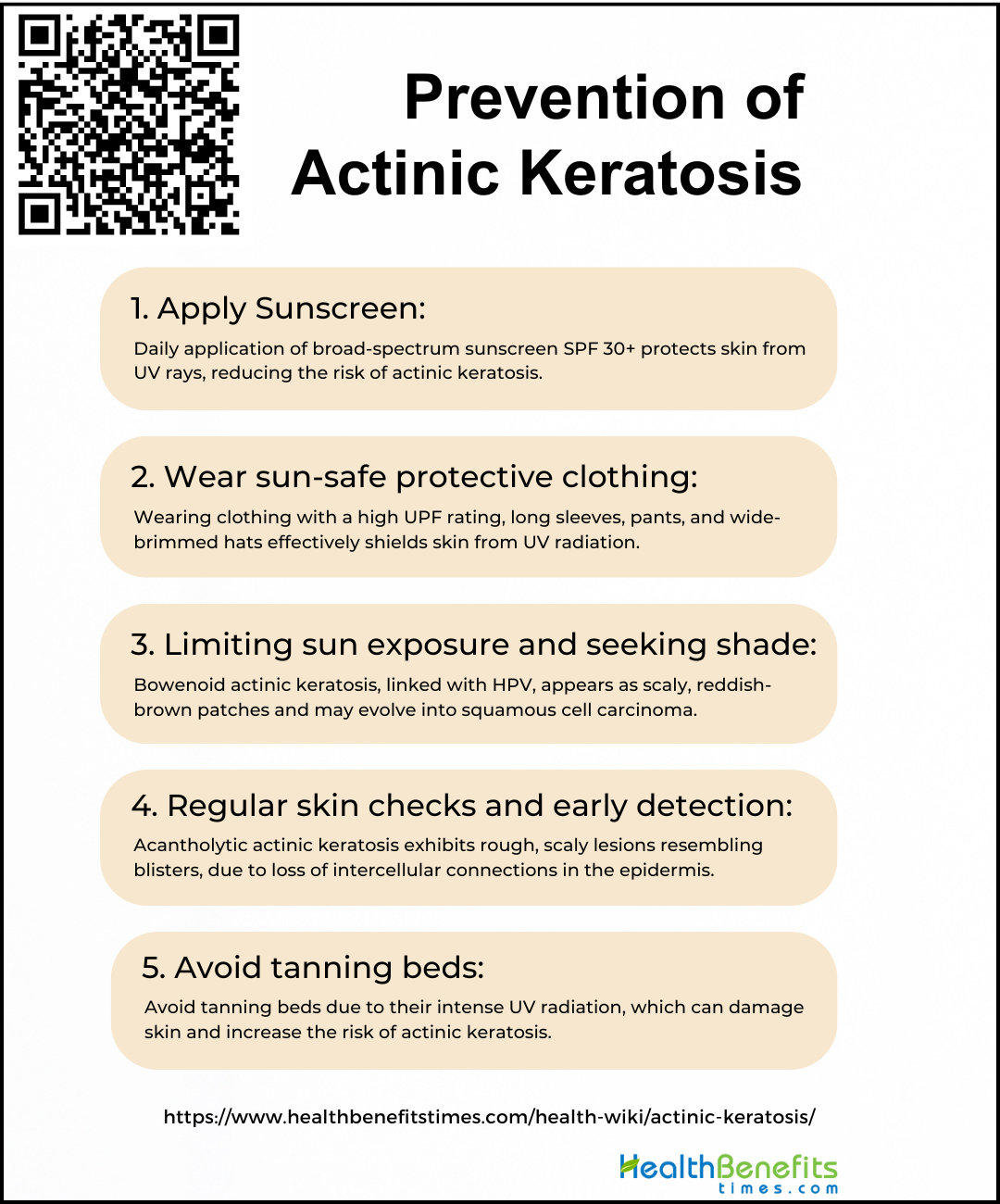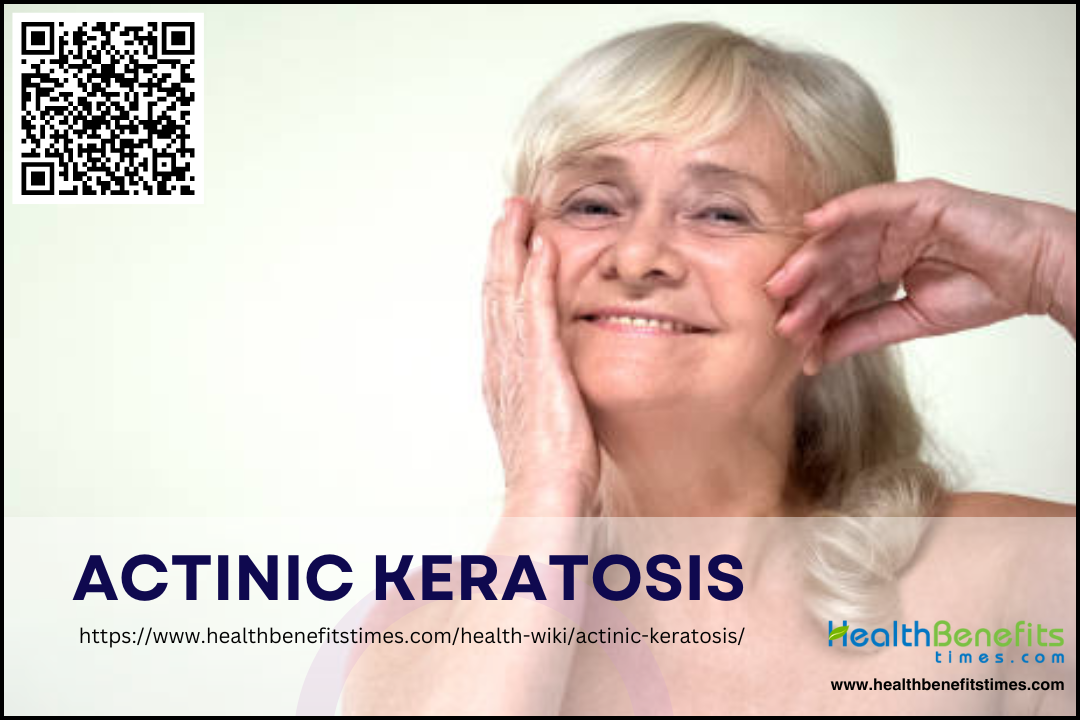Actinic keratosis (AK) is a rough, scaly spot on the skin from too much sun. It can turn into squamous cell carcinoma if not treated, but the chance of cancer is usually low. AK looks like a red patch and shows up on sun-touched areas like the face, ears, hands, arms, scalp, and neck. It takes years to show up after being in the sun. AK can feel rough and itchy or burn, and the spot might be bumpy or flat. To treat AK, doctors might freeze it off, give special creams, do chemical peels, or use light therapy.
Causes and Risk Factors of Actinic Keratosis
Knowing what causes a condition and what increases the risk is key to stopping it early. We’ll look at the many things that can lead to this health issue, showing why it’s so important to take care of our overall health to lower these risks.
1. Sun exposure and UV radiation
According to article, too much sun and harmful UV rays can cause actinic keratosis (AK), which might turn into cancer. These rough patches often show up on people with light skin who have been in the sun a lot, either for work or fun. If you have light hair and eyes, or use tanning beds, you’re at higher risk. To stop AK and keep your skin safe, it’s important to use sunscreen, wear hats and long sleeves, and stay in the shade when the sun is strongest. Good sun habits help prevent these risky spots and keep you healthy.
2. Fair skin and light-colored eyes
People with fair skin, light eyes, and red to blond hair are more at risk of actinic keratosis (AK) because they have less melanin. Melanin helps protect against UV rays. According to article, AK shows up as rough, scaly patches on the skin and can turn into skin cancer if not treated. To prevent AK, people with this skin type should wear protective clothes, use sunscreen that covers all types of UV rays, and stay out of the sun when it’s strongest. It’s important to take care of your skin health and overall well-being by following these sun safety steps.
3. Age and cumulative damage
As we get older, our skin struggles more with the sun. After 40, our natural defenses aren’t as strong. This can lead to actinic keratosis (AK), which are rough, scaly spots. They show up from too much sun over the years, like from sunbathing, outdoor work, or even a little bit of sun every day. People with light skin have a higher risk, and as we age, it’s harder for our bodies to fix DNA damage. That’s why it’s so important to catch these spots early and take good care of our skin. Looking after our skin isn’t just about looking good—it helps keep us healthy overall.
4. History of multiple or severe sunburns
Getting sunburned a lot, especially bad burns, can lead to actinic keratosis. This is an early warning of skin cancer. These burns hurt your skin cells’ DNA and cause weird growths where the sun hits your skin the most. If you got burned often when you were young, your risk is higher because UV damage adds up over time. People with pale skin, light eyes, and who freckle easily need to be extra careful in the sun. Knowing how dangerous UV rays are, we should use sunscreen, wear clothes that cover us up in the sun, and stay in the shade during peak hours. Doing this keeps our skin healthy and helps prevent actinic keratosis.
5. Weakened immune system
In the world of health and wellness, it’s very important to know the dangers of a weak immune system. This is especially true for actinic keratosis (AK), which can lead to skin cancer. AK appears as rough, scaly patches on the skin after too much sun and often affects people with weaker immune systems. This weakness can be due to illnesses like HIV/AIDS or leukemia, or from certain drugs used for organ transplants or autoimmune diseases. The immune system helps fix sun-damaged skin cells. If it’s not working well, the body can’t protect itself against harmful changes caused by UV rays, and this may lead to abnormal cell growth. To keep your immune system strong and help your skin fight off AK, eat plenty of nutritious foods, manage stress, and get enough sleep.
6. Working outdoors
People who work outside, like farmers, builders, and gardeners, have a higher chance of getting actinic keratosis (AK). This skin problem is caused by too much sun and can lead to rough, scaly spots on parts of the body that get a lot of sun, such as the face, ears, neck, scalp, and hands. It happens when the sun’s UV rays change the DNA in skin cells, which can cause unusual growths. To avoid AK, outdoor workers should use sunscreen, wear hats with wide brims, and stay in the shade when the sun is strongest. These steps can help keep their skin healthy.
7. Using tanning beds
Tanning beds, which can boost the risk of actinic keratosis—a skin issue that might turn into cancer—give off strong ultraviolet radiation. This can hurt your skin more than the sun. These fake UV rays make you age faster and can harm your cells a lot. This ups the chances of getting skin problems. People with light skin, a history of sunburns, or weak immune systems need to be extra careful. Health pros say to skip the tanning bed. They tell us to take care of our skin and practice safe sun habits. This helps keep our natural beauty and health in good shape.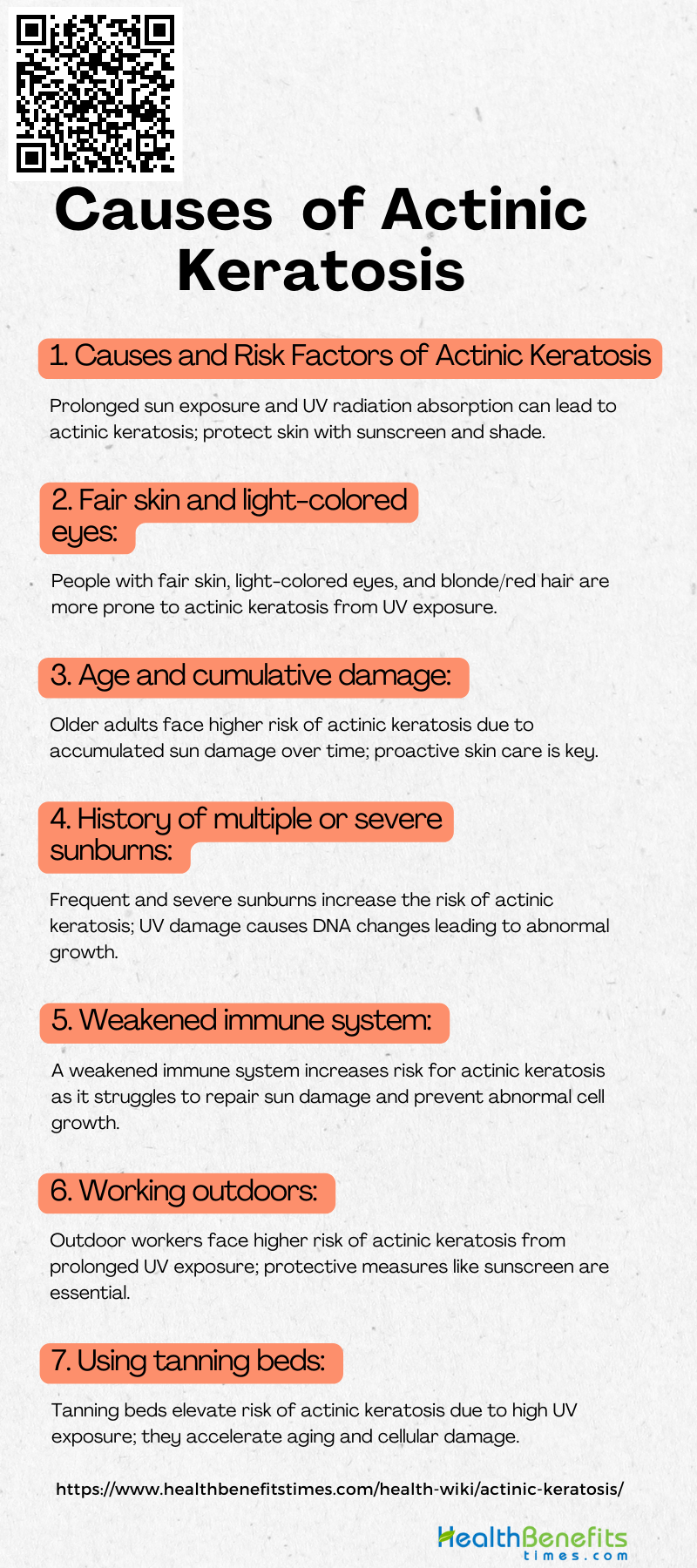
Symptoms and Appearance of Actinic Keratosis
Rough, scaly patches can show up on the skin in colors ranging from your skin tone to reddish-brown. These signs often pop up on parts of the body that get a lot of sun, like the face, ears, neck, and hands. It’s super important to notice these symptoms early. Doing so means you can get help sooner and lower the chance of them turning into skin cancer. This highlights why taking care of your whole self is key for staying healthy.
- Dry, rough and scaly patches of skin
- Raised spots that may look like a rash or acne breakout
- Scaly patched from 1cm to 2cm in size
- Scaley patches that are skin-coloured, pink, red, brown, white, yellow or grey
- Itchy, burning, bleeding, sore or crusty areas of skin
- Dry, scaly lip that never heals
- White patches or loss of colour on the lips
- Growth on the skin that looks like an animal’s horn
Types of Actinic Keratosis
Actinic Keratosis is a skin issue that can lead to cancer. It usually happens from being in the sun too much. There are different kinds of this condition, each with its own signs and effects on your health. Knowing these types helps catch the problem early, which makes treatment work better and fits with taking care of your whole health. Skin doctors stress how key it is to know these common forms to lower risks and keep your skin healthy.
1. Hypertrophic
Hypertrophic actinic keratosis (AK) is a skin condition that looks thick, wart-like, and scaly. It’s often found on sun-damaged areas like the face, ears, and hands. People between 55 and 70 years old usually get it because of too much UV light from the sun, which can lead to skin cancer called squamous cell carcinoma. To stay healthy, it’s important to catch and treat AK early. Wearing protective clothes and using natural sunscreens can help prevent these skin problems. Taking care of your skin helps keep it healthy and lowers the chances of AK getting worse. This is part of taking good care of your overall health.
2. Atrophic
According to article, Atrophic Actinic Keratosis (AK) is a skin condition that can sneak up on you. It’s caused by too much sun over the years and shows up as thin, flat spots that might not seem like a big deal at first. These spots have a thinner top skin layer and might be a bit red or scaly. They usually pop up on parts of your body that get a lot of sun, like your face, ears, and hands. Atrophic AK is a sign that your skin has been damaged by the sun for a long time, and it could lead to squamous cell carcinoma, a type of skin cancer. To keep your skin healthy, make sure you do things like wear sunscreen that protects against all types of sun rays, cover up with clothes, and stay in the shade when you can. Eating foods full of antioxidants and getting advice from a professional about how to treat this early can help stop atrophic AK from getting worse and keep your skin in good shape.
3. Bowenoid
Bowenoid actinic keratosis is a type of skin lesion that can turn into squamous cell carcinoma, a kind of skin cancer. It looks like Bowen’s disease and is often linked to the human papillomavirus (HPV), especially HPV type 144. It starts as a harmless seborrheic keratosis but can change into atrophic and bowenoid areas. These lesions show up as scaly reddish-brown spots, usually where the skin gets a lot of sun. Catching and treating Bowenoid AK early is crucial to stop it from becoming invasive cancer. To keep your skin healthy, it’s important to use sunscreen, wear protective clothing, check your skin regularly, and take good care of your skin.
4. Acantholytic
Acantholytic actinic keratosis (AK) is a type of AK that happens when skin cells lose their connections, leading to rough and scaly spots. These can look like blisters or crusty growths. It usually shows up on skin that gets a lot of sun, especially in people with light skin. It’s super important to protect yourself from the sun and to catch this early. Since it could turn into squamous cell carcinoma, a kind of skin cancer, keeping an eye on your skin and talking to a doctor is key. Using natural skincare and being safe in the sun can really help manage acantholytic AK and keep your skin healthy despite sun damage.
5. Pigmented
According to article, Pigmented actinic keratosis is a darker type of the usual sun spots and it can look a lot like melanoma. This makes it really important to keep an eye on your skin. People with light skin often get these flat or bumpy tan to dark brown spots from too much sun. They show up on places like the face and hands. Since they can be an early sign of skin cancer, it’s super important to tell them apart from more serious skin issues. Regular check-ups with a dermatologist are a must. To stay healthy, protect yourself from the sun, eat foods full of antioxidants, and use natural sunscreens. This way, you help prevent these spots from turning into worse types of skin cancer.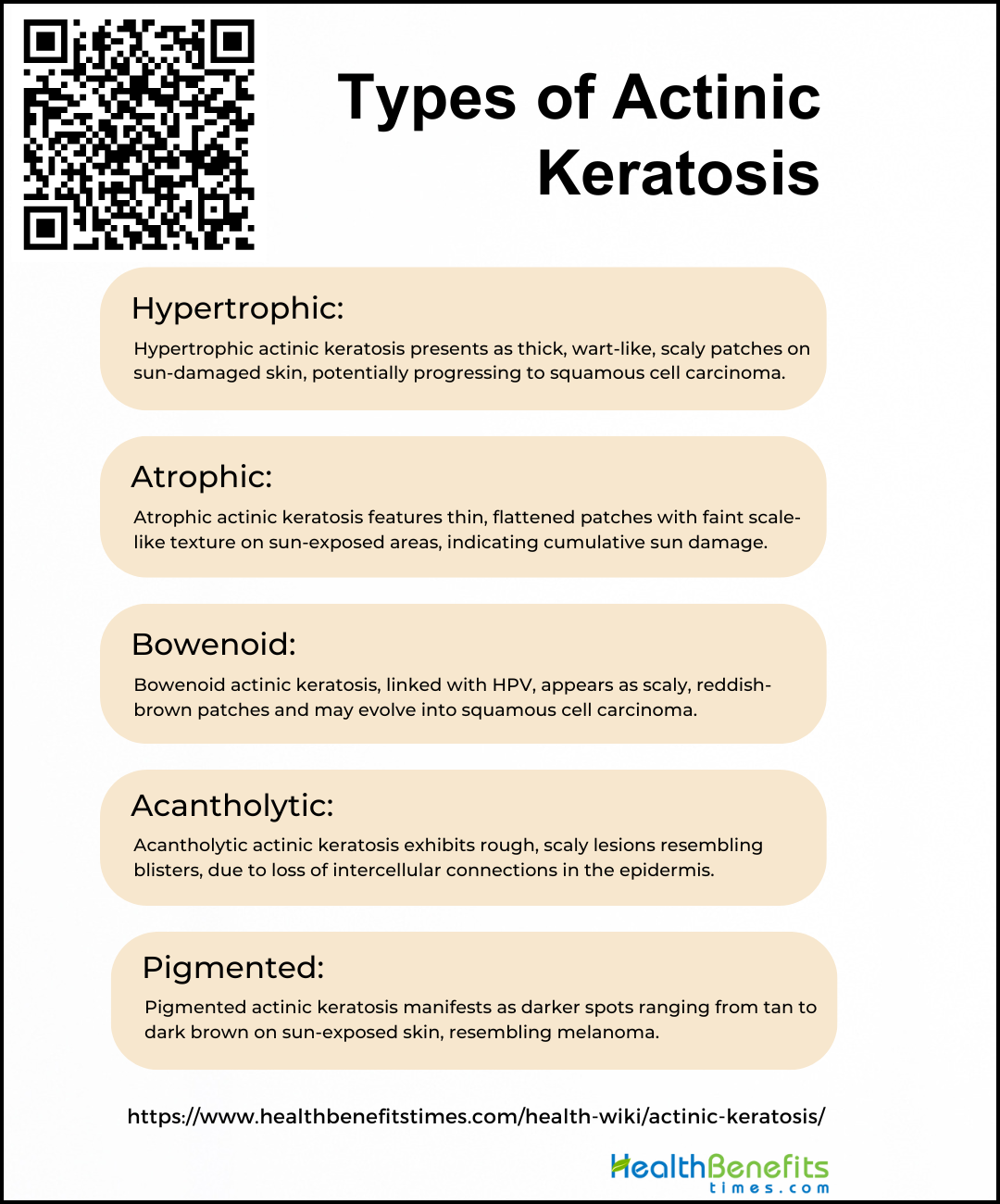
Diagnosis of Actinic Keratosis
Early detection and complete care for Actinic Keratosis are key. This skin problem shows up as rough, scaly patches from too much sun. It can lead to skin cancer if not treated early. Health experts follow certain steps to spot this condition and stop it from getting worse. Here’s what they usually do:
1. Visual examination and clinical evaluation
According to article, in the world of total health and wellness, spotting Actinic Keratosis (AK) is key. AK can lead to skin cancer, so it’s important to catch it early. Doctors, especially skin doctors, look closely at your skin. They check for rough, scaly spots where the sun hits often. They look at how they feel, their size, and color to see if they might be AK. They might use a special tool called a dermatoscope to see your skin better and make sure they know what’s going on. If they’re not sure or the spot looks odd, they might take a small piece of skin to test, just to be safe. Catching and handling AK early is super important. It can mean changing some habits, using creams, or keeping an eye on your skin. This helps stop bigger health problems later on.
2. Review of your past medical history
Understanding your medical history is key to diagnosing and treating Actinic Keratosis (AK), a skin condition that can lead to cancer. Doctors look closely at your past skin health, how much sun you’ve been exposed to, and any sunburns you’ve had because these factors are linked to AK. They also check if your family has had skin cancer to see if you might be more likely to get it. Knowing all this helps them not only diagnose AK correctly but also create a treatment plan just for you. This plan includes changes in your lifestyle, advice on what to eat, and ways to stay healthy to help your skin and stop more damage. This way, treating AK goes hand in hand with your overall health goals.
3. Dermatoscopy and skin biopsy
Dermatoscopy is now a key tool for spotting Actinic Keratosis (AK) early. It lets doctors see skin details that are invisible to the eye. This helps them tell AK apart from other skin issues, which is crucial for good treatment and meeting patients’ health goals. If dermoscopy isn’t clear or looks like cancer, doctors do a skin biopsy. This is the best way to diagnose. They take a small piece of skin and look at it under a microscope to check for AK and rule out more serious stuff, like squamous cell carcinoma. Using both dermatoscopy and skin biopsy is super important in healthcare. It makes sure people get care that fits their needs and helps stop diseases from getting worse.
4. Grading and staging of Actinic Keratosis
Understanding Actinic Keratosis (AK) is key for both traditional and natural skin treatments. Doctors grade these common, early-stage skin changes by looking at their thickness, roughness, and redness. These signs show how likely it is that they’ll turn into squamous cell carcinoma, a type of skin cancer. At first, AK might just seem like small, rough spots, but they can grow into thicker, more noticeable patches. Dermatologists classify AK from single spots to larger areas. This helps them mix standard treatments with natural methods, like diet changes and herbal remedies, to improve skin health and stop more damage. It’s really important to get expert advice to make a plan that fits your health goals. This highlights the need to prevent problems early and change your lifestyle if needed.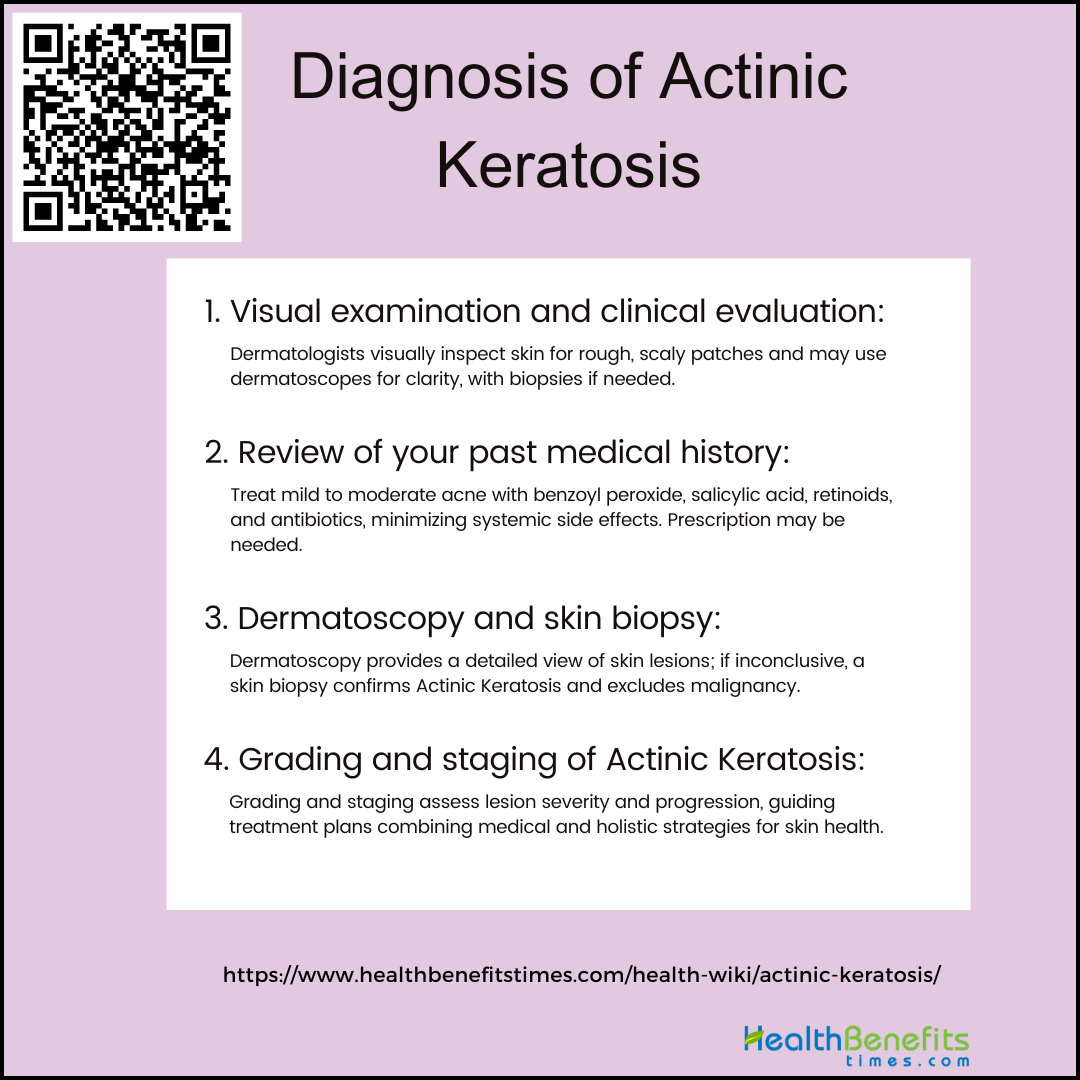
Treatment Options for Actinic Keratosis
Talking to a healthcare provider is key to get a treatment plan that’s just for you. But there are many natural and regular ways to handle and maybe even turn around this condition. Let’s look at different treatments that fit with a whole-body health and wellness way of life.
1. Topical medications and creams
According to article, Topical meds and creams are key in treating actinic keratosis (AK). This skin issue shows up as rough patches from too much sun and can lead to skin cancer. Prescription creams like fluorouracil and imiquimod help the immune system fight off weird cells. A gel called ingenol mebutate gets rid of AK cells and helps healthy skin heal fast. If you like natural stuff, aloe vera and green tea can soothe your skin and keep it healthy. Some treatments work better than others. For example, light therapy can hurt but it’s really good at fixing the problem. When picking a treatment, think about where the AK is, your health history, and what you can handle. It’s important to get care that fits you. Always talk to a doctor to find the best treatment for your health goals.
- Diclofenac skin gel (Voltaren® gel)
- Fluorouracil, or 5-FU skin cream (Fluorac®)
- Imiquimod skin cream (Aldara or Zyclara®)
- Ingenol mebutate topical gel (Picato®)
- Imiquimod Cream
- Klisyri
- Tirbanibulin ointment
2. Cryotherapy and freezing techniques
Cryotherapy is a trusted and effective way to treat actinic keratosis (AK), which can turn into cancer if ignored. It uses liquid nitrogen to quickly freeze the bad cells. This non-invasive method makes the spots flake off and lets healthy skin show up. Cryotherapy is fast and only hits the spots that need it, without hurting the skin around them. It also fits well with holistic health because it helps the body heal itself and doesn’t use drugs. Some people might get redness or blisters for a little while, but the high success rate and quick recovery make it a top choice. When dealing with AK, it’s good to also protect yourself from the sun and check your skin often.
3. Photodynamic therapy and laser treatment
Photodynamic Therapy (PDT) and laser treatments are becoming popular for treating actinic keratosis (AK), a skin condition from too much sun. These methods are gentle and support the body’s ability to heal itself. PDT uses a special cream on the skin that reacts to light, killing off bad cells but keeping good ones safe. Laser treatments, like CO2 and erbium: YAG lasers, carefully remove damaged skin layers, making way for new, healthy skin to grow. Both treatments have short recovery times and leave the skin looking great, making them a better choice than older surgery methods for AK.
4. Topical chemotherapy
According to article, Topical chemotherapy is a non-invasive way to treat actinic keratosis (AK). AK shows up as rough skin patches from too much sun. This treatment uses drugs like 5-fluorouracil (5-FU) and imiquimod to kill off the bad cells while keeping the good ones safe. It’s great at shrinking lesions and stopping them from getting worse. But, these treatments can irritate your skin and should be used with a doctor’s guidance. Along with these treatments, it’s also key to protect yourself from the sun and check your skin often to keep it healthy and lower your risk of AK.
5. Laser surgery
Laser surgery is a precise treatment for actinic keratosis, which comes from too much sun. This method uses focused light to get rid of bad skin cells while keeping the good ones safe. It’s less invasive than old treatments and uses modern tech with our body’s ability to heal itself. Recovery is fast with laser surgery. It helps stop skin cancer before it can start and fits well with a whole health approach. It’s great for people who want to keep their skin healthy and looking good without too much fuss.
6. Chemical Peels
Chemical peels are a straightforward treatment for actinic keratosis, which are rough skin patches from too much sun. They use a special liquid to take off the bad skin and help new, smooth skin grow. These peels make your skin look better and can stop it from turning into a kind of skin cancer. They work with your body’s way of healing itself. If you’re thinking about this treatment, talk to a doctor to make sure it’s right for you and that it’s done safely.
7. Excision
Excision is a way to treat actinic keratosis, which can turn into skin cancer due to too much sun. Doctors cut out the rough skin patches to stop them from becoming squamous cell carcinoma, a skin cancer type. It’s done with local anesthesia, is quick, and you won’t need much time to recover. Before deciding on excision, patients should talk to their doctors about things like where the lesion is, their health history, and if they can handle the treatment. To help with healing and stay healthy, they can also eat well, drink plenty of water, and use natural skin care methods.
8. Photodynamic therapy
Photodynamic therapy (PDT) is quickly becoming known as a good non-invasive treatment for actinic keratosis (AK), mainly in people with light skin. PDT uses a light-sensitive drug that, when activated by light, targets and kills off bad cells but keeps the good skin safe. It’s a great mix of new tech and natural healing. Because it works well, has few side effects, and doesn’t require much downtime, people who like holistic health are taking notice. They like that it taps into the body’s own power to heal. PDT also has great results that look good and the problem doesn’t come back often. This makes PDT a strong option for those wanting both effective treatment and to keep their skin looking nice when dealing with precancerous skin spots.
9. Dermabrasion
Dermabrasion is a skin-smoothing technique that’s good for fixing rough skin and getting rid of actinic keratosis, which are precancerous spots. This is especially helpful if you have lots of these spots. It’s not just for looks—it can also be a way to treat actinic keratosis, helping your body make new, healthy skin. You get this quick procedure at a dermatologist’s office with a little anesthesia. Afterward, it’s important to take care of your skin by staying out of the sun and following a skincare plan to help heal. Always talk to a doctor first to make sure dermabrasion is right for you and fits with your overall health goals.
10. Immunomodulator therapy
Immunomodulator therapy, using creams like imiquimod, is a way to treat rough, scaly skin patches from sun damage by boosting the body’s immune system to fight off weird cells. This method works well with natural health ideas because it helps keep the skin balanced and gets rid of many lesions. People usually use this treatment for about 7 weeks and might see some patches come back. Even though you might need to go to the hospital more often than with other treatments, this therapy is made just for you, looking at your own health history and the details of your skin patches. If you want a non-invasive option that helps your body heal itself, immunomodulator therapy is a strong choice in natural health care. But remember, it’s really important to talk with a doctor to make sure the treatment fits your specific needs.
11. Microtubule inhibitor
According to article, to keep your skin healthy all over, treating actinic keratosis (AK)—rough, scaly patches from sun damage—are key. Non-invasive treatments like creams that stop cells from growing can help. These creams, such as imiquimod, kill the bad cells that cause AK. A treatment called photodynamic therapy (PDT) works really well. It clears up the skin and doesn’t need many visits or much time. These treatments are part of a whole-body approach to skin care. They boost your immune system too. But they’re best for people with a lot of spots and should be used with a doctor’s help. This way, you treat your skin gently and make it part of your overall health routine.
12. Scraping (curettage)
Scraping, also known as curettage, is a simple and less invasive way to treat actinic keratosis. This skin issue comes from too much sun and shows up as precancerous spots. In this treatment, doctors use a small tool called a curette to carefully take off the bad skin. They often pair it with electrodessication, which uses electric currents to burn away any remaining abnormal tissue and stop bleeding. This method works well for single lesions, heals quickly, and most people handle it well. If you’re into holistic health, talk to your doctor about this option to learn about its pluses and possible risks.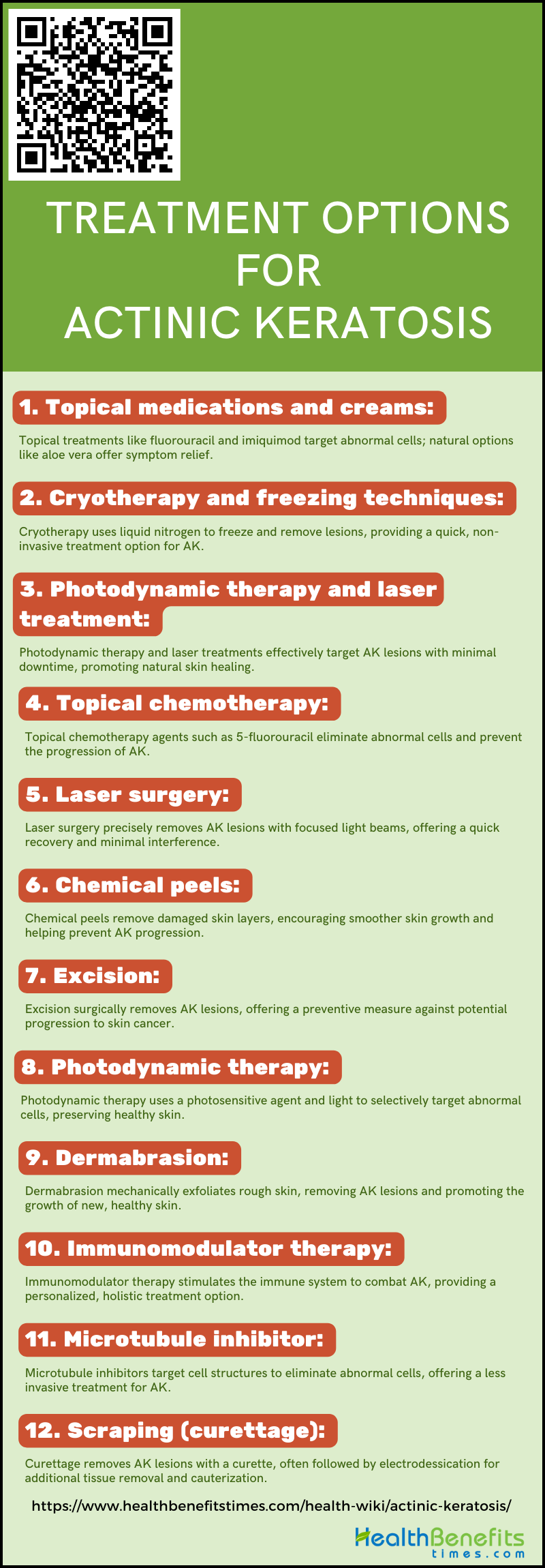
Prevention and Sun Protection of Actinic Keratosis
Emphasizing prevention through holistic health measures and rigorous sun protection can significantly reduce the risk of developing AK. Here are key strategies to safeguard your skin and maintain its wellness.
1. Apply Sunscreen
According to article, protect your skin from UV rays to avoid actinic keratosis. This condition causes rough, scaly patches on skin that gets a lot of sun. If you care about your health, use sunscreen with SPF 30 or more every day. It guards against UV rays and helps prevent skin damage. Put it on all over your skin, especially on your ears, neck, and hands. Remember to reapply every two hours, or after swimming or sweating. Use sunscreen even when it’s cloudy or cold. Doing this can keep your skin healthy and lower the chance of getting actinic keratosis. Your skin will thank you for it!
2. Wear sun-safe protective clothing
To protect your skin from harmful UV rays and lower the risk of actinic keratosis, it’s important to wear sun-safe clothes. This skin condition mainly comes from too much sun, so wearing clothes with a high UPF rating is key. Go for long-sleeved shirts, long pants, and hats with wide brims to cover up well. You can find brands that make clothes with UV-blocking tech too. Don’t forget to use broad-spectrum sunscreen on any skin that’s still showing. This way, you’ll have a strong shield against the sun and keep your skin healthy.
3. Limiting sun exposure and seeking shade
According to article, Staying in the shade and avoiding too much sun can help prevent actinic keratosis (AK). This skin problem could turn into squamous cell carcinoma if not taken care of. To keep your skin safe, hang out under trees, umbrellas, or canopies, especially from 10 a.m. to 4 p.m. when the sun is strongest. Try to do outdoor stuff early in the morning or later in the afternoon to cut down on risk. By doing these easy things and keeping an eye on the UV index, you’re not just lowering your chances of getting AK. You’re also taking care of your overall health by listening to what nature tells us.
4. Regular skin checks and early detection
According to article, to keep your health and wellness in check, it’s important to look out for actinic keratosis (AK). This skin issue usually shows up on parts of your body that get a lot of sun, like your face and hands. If you don’t catch it early, it could turn into skin cancer. So, make sure to examine your skin every month in a bright room. Use a mirror to see all areas of your skin. It’s also good to see a dermatologist once a year, especially if you’re often in the sun. By doing these checks and protecting yourself from the sun with sunscreen and clothes, you can lower your chances of getting AK and stay healthy.
5. Avoid tanning beds
According to article, To keep your skin safe from UV rays and lower the chance of getting actinic keratosis—a sign of possible skin cancer that looks like rough, scaly spots—it’s important to stay away from tanning beds. These machines give off strong UV light that can hurt your skin and make it more likely you’ll get skin cancer. Taking care of your body with good food and exercise is part of a healthy lifestyle, as well as avoiding harm. Try sunless tanning products like quality lotions or sprays instead, and be proud of your natural skin color. Also, using sunscreen that covers all types of UV rays and wearing clothes that protect your skin can keep it healthy. This way, you can feel good about how you take care of yourself.